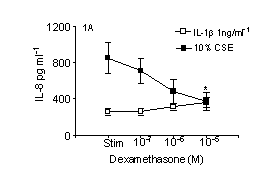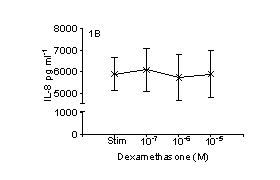| pA2 online © Copyright 2004 The British Pharmacological Society |
098P
GKT, University of London Winter Meeting December 2003 |
|
Dexamethasone
inhibits IL-8 release from THP-1 monocytes treated with cigarette
smoke extract (CSE) alone but has no affect on cells treated with
cse and IL-1ß |
|
COPD is a leading cause of morbidity and mortality in Europe and the US (ranked 3rd and 4th respectively). The main risk factors for COPD are smoking and occupational exposure to particulate matter. COPD is characterised by the recruitment of inflammatory cells, into the lung (Jeffery, 1998) with macrophages constituting 95-98%of this population and may play a key role in the pathology of COPD (Shapiro, 1999). We have already shown that CSE is capable of synergising with IL-1ß in the induction of IL-8 release from THP-1 monocytes (Walters, 2003). Here we examine the effect of dexamethasone on the release of IL-8 from these cells.
For 100% solutions, cigarette smoke was drawn from four cigarettes (full strength Marlboro) through 100mls of RPMI 1640 to produce our strongest smoke solution. The 'strength' of each smoke extract made was assessed by measuring nitrite levels using the Greiss reaction (Bishop-Bailey et al., 1997). CSE was diluted to the required strength with non smoked RPMI. Cells were pre-treated with Dexamethasone (10-7M - 10-5 M) for 1hour before being stimulated for a further 24hrs at 37°C after which time supernatants were collected and assayed for IL-8.
Treatment of cells with either 10% CSE or 1ng ml-1 IL-1ß caused a significant release in IL-8, 10% CSE plus 1ng ml-1 IL-1ß released IL-8 in a synergistic manner. Dexamethasone (10-7 - 10-5M) had no affect on IL-8 release induced by 1ng ml-1 IL-1ß alone (figure 1, n=4). Dexamethasone (10-5M) did however cause a significant decrease from cells treated with 10% CSE alone (p=<0.05, n=4 figure 1). When cells exposed to both 10% CSE and 1ng ml-1 IL-1ß were treated with dexamethasone (10-7 - 10-5M) no significant decrease in IL-8 release was observed (figure 1B).


Figure 1. The effect of Dexamethasone on IL-8 release induced by IL-1ß in the presence (1B) and absence of 10% CSE. Data are mean ± SEM. * p<0.05 One Way ANOVA with Dunnets post test.
These data show quite clearly that CSE induced IL-8 release is inhibited by an anti-inflammatory steroid. However when combined with a pro-inflammatory cytokine such as IL-1ß, CSE induced release is no longer sensitive to the action of dexamethasone. It is well known that smoking causes the release of pro-inflammatory cytokines which in an in vivo setting would be available to synergise with smoke. These findings may help to explain why steroids are not useful therapies for COPD.
Bishop-Bailey, D.,
Larkin, S.L., Williams, T.J et al. (1997), Brit. J. Pharmcol. 121;
125-133.
Jeffery P.K., (1998). Thorax. 53; 129-136.Shapiro, S. (1999). Am. J.
Respir. Crit. Care. Med. 160; S29-S32
Walters M.J, & J.A. Mitchell (2003) BJP,138; 44P.
This study was funded by an Industrial collaborative grant between the MRC and Yamanouchi.